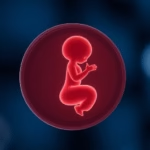Understanding Implantation Bleeding
Implantation bleeding occurs when a fertilized egg attaches to the lining of the uterus, often resulting in light bleeding or spotting. This typically happens 6 to 12 days after conception when the embryo burrows into the uterine wall. Many women mistake this light bleeding for an early period, but it is usually much milder and shorter in duration. Recognizing the difference between implantation bleeding and a menstrual period is essential for understanding early pregnancy signs. The timing of a positive pregnancy test is crucial after noticing this type of bleeding, and it can significantly influence how soon a woman will have a confirmed pregnancy.
What Causes Implantation Bleeding?
Implantation bleeding is primarily caused by the embryo’s attachment to the uterine wall. During this process, tiny blood vessels can break, leading to light spotting. The blood may appear pink or brown rather than the bright red typically associated with menstrual flow. This breaking of blood vessels can also cause mild cramping, which is another sign that implantation has occurred. It’s important to stress that not all women experience this bleeding; some may have no signs at all during the early stages of pregnancy. However, for those who do, understanding why it occurs can help with recognizing it as a normal part of the early pregnancy process.
How to Identify Implantation Bleeding
Identifying implantation bleeding requires understanding its characteristics. This type of bleeding typically differs significantly from a menstrual period. Firstly, implantation bleeding usually occurs much earlier than a missed period. Women often report spotting lasting only a few hours to a couple of days, while their menstrual flow typically lasts longer. The color of the bleeding can also vary; implantation bleeding is commonly light pink or brown. It may also come with milder cramping than usual. To effectively distinguish between the two, tracking the onset of the bleeding and correlating it with your menstrual cycle can provide valuable insights into whether you may be experiencing implantation bleeding.
The Timing of a Positive Pregnancy Test
The timing of a positive pregnancy test after experiencing implantation bleeding can vary. Most women opt to take a home pregnancy test at least one week after the bleeding has occurred, or around the time of their expected period. This is when the hormone hCG (human chorionic gonadotropin) generally reaches detectable levels in the urine. Some sensitive tests promise results a few days earlier, but taking the test too soon can lead to false negatives. Allowing sufficient time post-implantation bleeding greatly increases the chances of an accurate result. If negative results are obtained despite missed periods and symptoms, it’s advisable to wait a few days and retest, or consult a healthcare provider for a blood test for confirmation.
Symptoms Accompanying Implantation Bleeding
Understanding the symptoms that accompany implantation bleeding can aid in recognizing pregnancy early. In addition to light spotting, women may experience mild to moderate cramping. Some may notice breast tenderness, fatigue, nausea, or frequent urination as early pregnancy symptoms. These signs can occur simultaneously with or shortly after the bleeding. It’s important to note that every woman’s experience is different; therefore, not all women will exhibit the same combination of symptoms. Keeping track of these symptoms can not only help identify potential pregnancy but can also help in preparing for the upcoming changes.
Differences Between Implantation Bleeding and Menstrual Bleeding
A significant aspect to understand is the differences between implantation bleeding and menstrual bleeding. Implantation bleeding tends to be lighter in color and flow, commonly described as spotting rather than a continuous flow. In contrast, menstrual bleeding is typically darker, redder, and heavier, lasting more than a couple of days. Additionally, menstrual periods are generally accompanied by more pronounced cramping, while implantation bleeding may come with only mild discomfort. Recognizing these differences can help in early detection of pregnancy and assist women in making informed decisions regarding their health.
When to Consult a Doctor
While implantation bleeding is generally harmless, there are times when it’s essential to consult a doctor. If the bleeding is heavy, accompanied by severe pain, or if it continues for an extended period, it could indicate a problem such as an ectopic pregnancy or miscarriage. Women who are unsure about their symptoms or if there are concerns about normalcy should always reach out to a healthcare professional for advice. Understanding when to seek help can provide peace of mind and ensure appropriate care is received.
Understanding the Role of hCG in Pregnancy Testing
hCG, or human chorionic gonadotropin, is a hormone produced by the placenta shortly after a fertilized egg attaches to the uterine lining. This hormone is an indicator of pregnancy and is what home and laboratory tests measure when determining if a woman is pregnant. The levels of hCG can be detected in both blood and urine. It typically increases rapidly in the early stages, peaking around 8-11 weeks of pregnancy. Understanding the role of hCG can clarify why testing too soon may lead to inaccurate results, as it takes time for levels to rise sufficiently post-implantation to show on tests.
Impact of Lifestyle Choices on Early Pregnancy
The choices you make regarding your lifestyle can significantly impact early pregnancy and overall health. For instance, maintaining a balanced diet rich in nutrients, staying hydrated, and avoiding harmful substances such as alcohol and nicotine are all crucial for fetal development. Incorporating prenatal vitamins with folic acid can help prevent neural tube defects. Regular, light exercise can also improve mood and energy levels while mitigating stress. It’s vital for expecting mothers to adopt healthy lifestyle practices early on to support their health and the health of their developing baby.
Emotional Changes During Early Pregnancy
Early pregnancy can be a time of profound emotional changes. Hormonal fluctuations can lead to mood swings, anxiety, and excitement, often creating a rollercoaster of feelings. Understanding that these feelings are normal can help women navigate the emotional landscape during this time. Support from partners, family, and friends can be beneficial, offering comfort and understanding. Establishing good communication and having a strong support network can enhance emotional well-being, making the journey through early pregnancy more manageable.
Conclusion
In conclusion, understanding the timeline of implantation bleeding and its subsequent positive pregnancy test is vital for those trying to conceive or suspecting pregnancy. Knowing the causes, identifying signs, and recognizing differences from menstrual bleeding can help women differentiate their experiences. The timing of pregnancy tests matters significantly, as it relates directly to hCG hormone levels. Additionally, awareness of accompanying symptoms, lifestyle choices, and emotional changes can alter the experience of early pregnancy.
For the best accuracy, take a pregnancy test at least a week after experiencing implantation bleeding. Consulting a healthcare provider regarding any concerns ensures health and well-being during this transformative time. Integrating healthy habits in your daily routine can support both maternal and fetal health. Remember, while each woman’s experience is unique, recognizing early signs can lead to informed choices and a healthier path forward into motherhood.
Frequently Asked Questions
- What is implantation bleeding? Implantation bleeding is light spotting that occurs when a fertilized egg attaches to the uterine lining, typically occurring 6 to 12 days after conception.
- How do I know if it’s implantation bleeding? Implantation bleeding tends to be lighter in color and flow, often pink or brown, and lasts for a short duration compared to a menstrual period.
- When should I take a pregnancy test after implantation bleeding? It is best to wait at least a week after noticing implantation bleeding to take a home pregnancy test for accurate results.
- What should I do if the bleeding is heavy? If you experience heavy bleeding or severe pain during early pregnancy, seek medical attention immediately.
- Can lifestyle choices affect early pregnancy? Yes, lifestyle choices such as diet, exercise, and avoiding harmful substances significantly impact early pregnancy health.
Further Reading
3.5 tog sleeping bag temperature guide
What Type of Psychotherapy Is Best for Anxiety?







